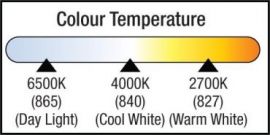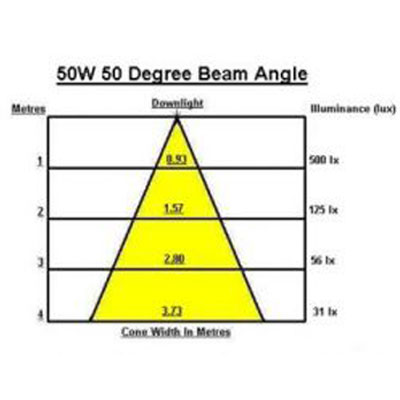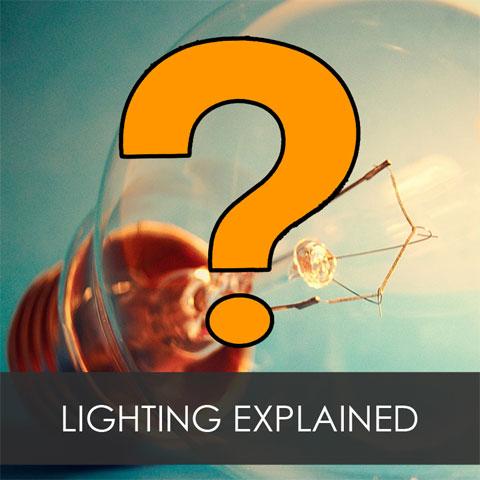Lighting Explained
There are many different terminologies and abbreviations used to describe light sources. This article explains the most important ones used at Downlights Direct.
CCT Correlated Colour Temperature
CCT and CRI
Correlated colour temperature (CCT) measures the colour appearance of the light itself and “colour rendering index” (CRI) measures the colour of the object it is illuminating. Both are helpful tools to use when choosing and comparing light sources but both have their limitations.
CCT(Correlated Colour Temperature)
The measurement of colour is expressed in Kelvin (k). The lower the Kelvin rating the “warmer” or more orange the light will appear. The higher the rating the “cooler” or more blue the light will appear. Standard halogen bulbs are 2700K which is classed as extra warm white, CFL (compact fluorescent lamps) lamps and LED (light emitted diode) lamps are now available in 3000K warm white which would give the same appearance as halogen.
CFL and LED are also available in 4000K cool white and 6500K daylight. Each one is a bright as each other, in terms of lumens. Selecting the right one is a matter of personal choice. Here are the most popular colour temperatures for lighting:
- Extra warm white 2700K (colour of a standard halogen GU10)
- Warm white 3000K
- White 3500K (colour of fluorescents used in warehouses)
- Cool white or natural white 4000K
- Daylight 6500K

CRI (Colour Rendering Index)
CRI stands for Colour Rendering Index; it is measured from 0 to 100 with 100 being the highest. Without trying to be too Scientific, CRI is a rating system that describes how a light source affects the colour appearance of objects. It is a way of judging how a light source accurately reproduces the correct shade of colour of an object in comparison to how it would look in natural daylight conditions.
For example; in a butchers, meat viewed under a light source with a low level of CRI would make it appear stale and brown whilst meat viewed under a light source with a high level of CRI would make it appear fresher by accenting the red. Cheaper, older generation LED lamps have a very low CRI level and do not reproduce colours accurately. The latest generation of higher powered LED lamps or LED downlights have a CRI of 82 making the colour of an object appear more natural and accurate.
Wattage
Watts (W) is an International standard unit of power. Wattage is used to measure the power being used by an electrical device, in this case a light source. The higher the wattage of a lamp, the more electricity it uses and the more expensive it costs to run.
Wattage used to be used an easy way of comparing the brightness of lamps but with the arrival of low energy lamps this is no longer the case. Low energy lamps use fewer watts to achieve the same level of brightness. For example an 11W compact fluorescent lamp would be as bright as a 60W incandescent lamp with energy savings of 82%.
The lamps below are as bright as each other but each one uses a different amount of wattage. The common denominator with lighting is compare the lumens, with all of these producing around 806 lumens to be able to classify them as a 60W alternative.
 |  |  |  |
| 60W Incandescent | 42W Halogen Energy Saver | 11W Compact Fluorescent | 8W LED |
Voltage
The majority of lamps are powered directly from the mains supply which in the UK is 230v AC (alternating current). Low voltage halogens such as MR16 dichroics or G4 capsule lamps have a 12V supply voltage and require a low voltage transformer to power them. Using low voltage transformers instead of mains GU10 lamps does provide some energy saving benefits but the savings are marginal especially when compared to the 90% energy savings available from LED lighting. The main advantage of using low voltage transformers is the increase in life expectancy of the lamps.
Transformers can help to protect lamps from voltage surges and spikes whilst mains voltage GU10s are left totally unprotected. This is one of the main reasons why mains voltage GU10s seem to need replacing all of the time. However, mains voltage GU10 halogens are still the number one choice as they are cheaper especially when larger quantities of downlights are needed.
A device called Energy Ace, which is fitted above the consumer unit and optimises the voltage, reducing it to 220V. This device lowers energy costs by around 20% and extends the life expectancy of lamps anywhere in the house.
As with low voltage halogens, most LEDs are low voltage and require their own LED driver to power them. LED drivers are different to low voltage transformers as they provide a constant DC (direct current) supply. LEDs should be used with the manufacturers recommended driver to avoid shortening the life expectancy. The latest range of power LED downlights come with a built in LED driver to make ordering easier.
Life Expectancy
The table below compares the life expectancies between various light sources. As lighting technology advances, the latest generation of LED downlights now lasts for 75,000 hours, 75 times longer than incandescent. As the majority of people don’t leave their lights on for every minute of the day, the days before changing section is based on 6 hours per day use. This shows how long each light source will actually last for in years.
| Lamp Type | Wattage | Average Life | Expectancy (6 hours a day use) |
| Incandescent | 60W light bulb | 1,000 Hours | 166 Days |
| Halogen GLS Replacement | 42W GLS Shape | 2,000 Hours | 333 Days |
| Halogen Standard | 50W GU10 | 2,000 Hours | 333 Days |
| Halogen Long Life | 50W GU10 | 4,000 Hours | 666 Days |
| Compact Fluorescent | 11W Kosnic GU10 | 8,000 Hours | 1,333 Days (3.8 years) |
| Compact Fluorescent | 11W Megaman GU10 | 15,000 Hours | 2,500 Days (6.8 years) |
| Power LED Bulb | 4W or 5W Kosnic | 30,000 Hours | 5,000 Days (13.6 years) |
| Dimmable Power LED | 7W Philips Master | 40,000 Hours | 6,640 Days (18.2 years) |
| LED Downlight | 3x3W Halers EvoLED | 75,000 Hours | 12,500 Days (30 years) |
Lumen & Luminous Flux
A unit of luminous flux is known as a lumen or lm. One lumen is defined as the luminous flux of light produced by a light source that emits one candela (cd) of luminous intensity over a solid angle of one steradian. It is very important to check the lumen output of a bulb especially when comparing LED bulbs. With many variations of LED bulbs currently available that claim to provide the equivalent light output to a 50W halogen, 5W or 7W power LEDs should be about 300lm. Some manufactures will not provide this information as their lumen is very low and will only concentrate on the low wattage.
Lumen Per Watt (lm/W)
This is the amount of light output per watt of electricity. This term is generally used to describe the efficiacy or efficiency of a light source. Lumen per watt is calculated by taking the overall lumens from a light source and dividing it by the wattage. For example; a 5W power LED lamp has 330 lumens and 66lm/W (330 divided by 5 equals 66). To comply with Part L of the Building regulations, light sources should be above 40lm/W.
Lux
Lux known as lx is a unit of illuminance and luminous emittance. 1lx is the same as 1 lumen per square metre. The difference between lux and lumen is that lux takes into account the area over which the luminous flux is spread. A flux of 1,000 lumens, concentrated into an area of one square metre, lights up that square metre with an illuminance of 1,000 lux. The same 1,000 lumens, spread out over ten square metres produces a dimmer illuminance of 100 lux.
Candela
Candela is identified as cd, this is the luminous intensity of a light source in a given direction with a radius of 1 metre. Candela is used as a common way of measuring and comparing light as perceived by the human eye. At a distance of 1 metre, 1 candela or 1cd has the same luminous intensity as an ordinary household wax candle. A 100W incandescent light bulb is approximately 120cd, 120 times brighter than a candle at 1 metre distance. A candle emits light in every direction; if some of the light emissions are blocked then the remaining emissions are still 1cd.
Lamps used in downlights such as halogen bulbs need to use their light more effectively as the light is only shining in one direction. If the light shone in all directions like a wax candle or GLS (General Lighting Service) light bulb then most of the light would be wasted. Because halogen reflector bulbs emit light in one direction it makes them the perfect choice for use in downlights.
Reflector style bulbs with the popular GU10 (mains voltage) cap, or less popular GU5.3 (low voltage) not only shine the light directly downwards but are available in a choice of beam angles. The wax candle example distributes its light in all directions, while the reflector lamps are more directed within a cone shape.

Here's a comparison of two different types of beam angles; the reflector lamps are both 50W, the first has a 25 degree beam angle and the second has a 50 degree beam angle:
 |  |
| Narrow, but more intense. | Wider, less intense. |

Up to a distance of 1 metre the candle emits 1cd of light in every direction. The 50W halogen with a 25 degree beam angle emits 1100cd of light at 1 metre, spreading the light over 430mm. The 50W halogen with a 50 degree beam angle emits 500cd of light at 1 metre, spreading the light over a larger area of 930mm. At distances greater than 1 metre, light is measured in lumens per square metre known as lux or lx. 1lx is the same as 1 lumen per square metre.At a distance of 2 metres the 25 degree halogen is reduced to 275 lx. The 50 degree halogen is 125 lx.

